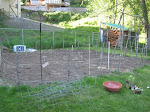Lying between the mountain and the walls of Jerusalem, is the Kidron Valley. Tradition holds that the resurrection of the dead on the Day of Judgement will happen here. Because of this it has been used as a burial grounds continually for 3000 years, making it the largest cemetery in Israel and possibly the world.
Stones are placed on top of the graves in memory of the
person buried there. Some also have little alcoves for
lighting candles.
It is recorded in Luke 19 that when Jesus drew near the city on Palm Sunday, He stopped and wept over it. In 1955, a church was built on the site called Dominus Flevit ("the Lord wept").
We stopped here to have some reflection time and a moment to hear about the significance of the place...
I found all the stuff lying around amusing and interesting
There is also a view from here of the Russian Orthodox Church of Mary Magdalene...
The gardener there cut us off some branches from a thorn tree like the one that would have been used for Christ's crown of thorns.
There was also a locust tree growing there in the garden. I was disappointed to learn that John the Baptist probably didn't eat bugs but possibly the beans and pods from the locust, or carob, tree. There is also speculation that it was possibly honey cakes and the Greek word is very similar to locust.
When excavating for the church, they discovered many 1st century bone boxes...
Then we headed down the very steep road towards Gethsemane. It wouldn't have been so bad if I wasn't wearing kind of slippery shoes. The stones had been rubbed so smooth over the years and millions of feet walking over them that it was unbelievably slick. Like scary slick!
This random sign was sticking out of the wall
but there wasn't a coffee shop anywhere???
We also passed by a few examples of a Jerusalem cross. It is also known as the Crusader cross and was used by the Crusaders after the capture of the city in 1099. Some believe that the large cross in the center represents Christ while the four smaller crosses are the four Gospels (Matthew, Mark, Luke, John) or the four corners of the world where the Gospel is to be taken. Other historians believe they are the five wounds of Christ on the cross.































No comments:
Post a Comment